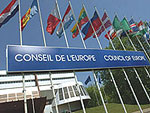12 November 2006
The sponsor of our project


About the Council of Europe
 Origins and membership
Origins and membership
The Council of Europe is the continent's oldest political organisation, founded in 1949. It:
• groups together 46 countries, including 21 countries from Central and Eastern Europe,
• has application from two more countries (Belarus and Montenegro),
• has granted observer status to 5 more countries (the Holy See, the United States, Canada, Japan and Mexico),
• is distinct from the 25-nation European Union, but no country has ever joined the Union without first belonging to the Council of Europe,
• has its headquarters in Strasbourg, in north-eastern France.
|
Aims
The Council was set up to:
• defend human rights, parliamentary democracy and the rule of law,
• develop continent-wide agreements to standardise member countries' social and legal practices,
• promote awareness of a European identity based on shared values and cutting across different cultures.
Since 1989, its main job has become:
• acting as a political anchor and human rights watchdog for Europe's post-communist democracies,
• assisting the countries of central and eastern Europe in carrying out and consolidating political, legal and constitutional reform in parallel with economic reform,
• providing know-how in areas such as human rights, local democracy, education, culture and the environment.
Political aims
The Council of Europe's Vienna Summit in October 1993 set out new political aims. The Heads of State and Government cast the Council of Europe as the guardian of democratic security - founded on human rights, democracy and the rule of law. Democratic security is an essential complement to military security, and is a pre-requisite for the continent's stability and peace.
During the Second Summit in Strasbourg in October 1997, the Heads of State and Government adopted an action plan to strengthen the Council of Europe's work in four areas: democracy and human rights, social cohesion, the security of citizens and democratic values and cultural diversity.
The Council of Europe's third Summit of Heads of State and Government, held in Warsaw on 16 and 17 May 2005, concluded by adopting a political declaration and an action plan laying down the principal tasks of the Council of Europe in the coming years:
- promoting the common fundamental values of human rights, the rule of law and democracy;
- strengthening the security of European citizens, in particular by combating terrorism, organised crime and trafficking in human beings;
- fostering co-operation with other international and European organisations.
Today, the Organisation continues to grow while at the same time increasing its monitoring to ensure that all its members respect the obligations and commitments they entered into when they joined.
How it works
The main component parts of the Council of Europe are:
• the Committee of Ministers, composed of the 46 Foreign ministers or their Strasbourg-based deputies (ambassadors/permanent representatives), which is the Organisation's decision-making body.
• the Parliamentary Assembly, grouping 630 members (315 representatives and 315 substitutes) from the 46 national parliaments. The current President is René van der Linden (the Netherlands, EPP/CD).
• the Congress of Local and Regional Authorities, composed of a Chamber of Local Authorities and a Chamber of Regions. Its current President is Halvdan Skard (Norway, SOC)
• the 1800-strong secretariat headed since September 2004 by Secretary General Terry Davis (United Kingdom, SOC), former Vice-President of the Parliamentary Assembly and former President of the Socialist Group of the Assembly.
Ordinary budget
In 2006, 190 148 800 euros.
Some practical achievements
• 200 legally binding European treaties or conventions many of which are open to non-member states on topics ranging from human rights to the fight against organised crime and from the prevention of torture to data protection or cultural co-operation.
• Recommendations to governments setting out policy guidelines on such issues as legal matters, health, education, culture and sport.
The pan-European dimension
Since November 1990, the accession of 21 countries of central and eastern Europe has given the Council of Europe a genuine pan-European dimension, so that it is now the organisation that represents Greater Europe.
15.06.2006
Source: http://www.coe.int
16:30 Posted in Nos parrains - Our sponsors | Permalink | Comments (0)










The comments are closed.